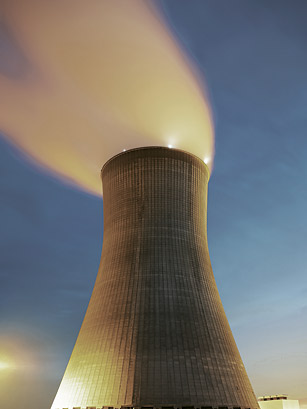
Nuclear-powered cars! airplanes! Fridges and freezers! In the heady days of the early 1950s — at the dawn of the civilian nuclear power age and President Eisenhower’s Atoms for Peace program — nuclear optimists imagined a world powered by tiny nuclear reactors. Today, in an era of climate change and energy insecurity, the nuclear industry is dusting off some of those old dreams. That includes the nuclear battery. Designed by the Los Alamos National Laboratory spin-off Hyperion Power Generation Inc., the nuclear battery — so called because it is cheap, small and easily transportable — is about the size of a refrigerator, compared with a 50-ft.-tall traditional reactor. It produces 25 megawatts of electricity — approximately a fortieth the output of a large atomic power-plant reactor. While not quite compact enough for cars, the battery, known as the Hyperion Power Module, has been designed to power subdivisions or towns with fewer than 20,000 homes, as well as military bases, mining operations, desalination plants and even commercial ships, including cruise liners. “Think of us as the iPhone of nuclear reactors,” Hyperion Power’s tanned and enthusiastic Denver-based CEO, John “Grizz” Deal, says. “Our technology is a game changer. There are so many exciting applications.” Some high-powered energy experts share that excitement. In a recent editorial, Energy Secretary Steven Chu endorsed so-called small modular reactors — a category that includes the Hyperion Power Module as well as models by NuScale Power, Toshiba, Westinghouse, Babcock & Wilcox and others — calling them “the new nuclear option.” It is not an option endorsed by some environmental groups, which are concerned that nuclear batteries will only spur nuclear proliferation, increase nuclear waste and be vulnerable to terrorism. The upside of small nukes lies in cutting not only greenhouse gases but also costs. Chu pointed out that small reactors like the ones built by Hyperion are sold as ready-made, turnkey devices, which will likely keep construction costs down. Hyperion estimates it will take $100 million to build and 25 employees to run one of its plants, compared with the $4 billion to $6 billion in capital needed to build a traditional plant and the roughly 300 people needed to run one. Small reactors appeal particularly to the developing world because they are a microgrid solution. Many poorer countries lack the robust electrical grids needed to handle the massive output of a large nuclear power plant. According to Deal, of the 130 units Hyperion says it hopes to sell in the near future, over a hundred will be outside the U.S. — as far afield as Kenya, Cambodia and Saudi Arabia. The company is still raising funds and has yet to receive permission to build any reactors, but Deal says a combination of political support and economics means Hyperion will break ground on the first projects within the next few years. Such enthusiasm has been a long time coming. Nuclear power grew 750% in the 1970s and 140% in the 1980s, but after high-profile accidents at Three Mile Island in Pennsylvania in 1979 and Chernobyl in 1986, it increased only 8% in the 1990s. Still, government officials, corporate types and many green activists acknowledge that atomic energy can play an important role in combatting global warming. Today nuclear power plants operating in more than 30 countries produce 15% of the world’s electricity. If that energy came from burning fossil fuels, it would result in more than 2 billion metric tons of carbon dioxide emissions each year, about 20% of all the emissions from power generation. In the U.S., the greenhouse-gas savings from nuclear-generated electricity are almost equal to the total emissions released by the country’s passenger cars. “To meet our growing energy needs and prevent the worst consequences of climate change, we’ll need to increase our supply of nuclear power. It’s that simple,” President Barack Obama said last year. The problem with that sentiment, some environmentalists say, is that a lot can go wrong with nuclear power. Aside from fears of another Chernobyl and the high costs of traditional plants, there is the nuclear waste associated with splitting uranium atoms. It remains radioactive for thousands of years and requires deep burial, which most communities are understandably reluctant to accept. But that’s another selling point for nuclear batteries — they produce only about a fortieth of the toxic waste of traditional plants. See TIME’s cover story on the Three Mile Island nuclear disaster.